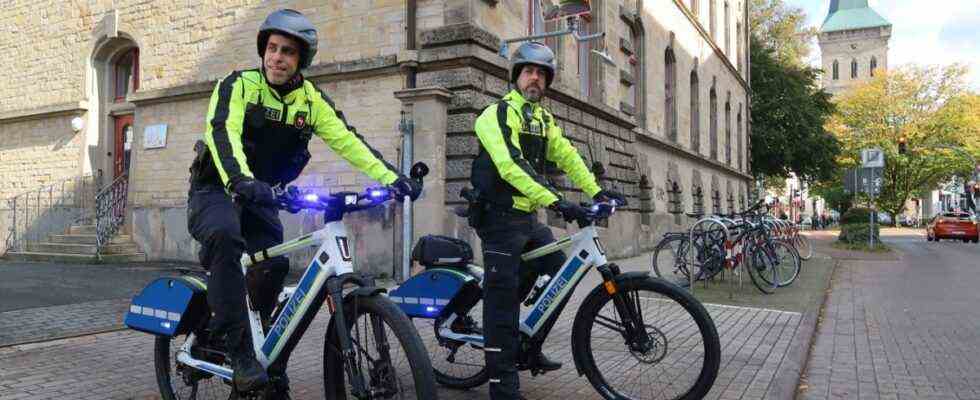They are well known, the officers of the Osnabrück bicycle relay. When Henner Salow (39) and Dennis Boddenberg (44) stop at the traffic light with their e-bikes, they are immediately spoken to. “Do you want one too?” Slurps a young man who has sat down in a doorway with a case of beer. High Commissioner Salow refuses. “Maybe later,” he replies, pedaling.
The two policemen can be seen from afar: their jackets are bright yellow, their bicycles are covered with reflectors. The matter only becomes really “police” when you press a button on the steering wheel. Then the bike flashes and glows in a glistening blue. Another button makes the 1.3 kilo martins horn howl, which is located in a side pocket. The bike cops are on two wheels, but the way they sound like they could be on a police bus.
This is a novelty in Germany. Nowhere else do police officers ride around with bicycles equipped with flashing lights and sirens. “Some smile at that,” says Salow, “but the feedback has been consistently positive. We are now greeted by people who previously didn’t look at us.” Her patrol through Osnabrück shows that this is not just an advertising slogan. At almost every corner they are spoken to, photographed or asked for details about their vehicles – they have not even switched on the special signals.
The sporty S-Pedelecs make an impression. “S” stands for speed, in this case up to 45 km / h. At such a speed, two-wheelers must have a license plate and are not allowed to ride on the bike path. “We are on site very quickly,” enthuses Superintendent Salow. Before the Fahrradstaffel was founded in April 2020, he was out and about in a patrol car for ten years. “No comparison,” he says today. He likes the fresh air.
The bicycle policemen are sometimes laughed at, but much more often they are greeted in a friendly manner
The eye-catching e-bikes have a serious background: The officers should be seen better when they rush to operations. In other cities, the bicycle police still have to ring the bell to clear their way through pedestrian zones. In combination with a fast e-bike, careless passers-by can quickly become a danger. Siegfried Brockmann, Head of Accident Research at the insurer, sees it similarly. In terms of numbers, the fast S-Pedelecs hardly played a role in Germany. But: “You are ultimately a motor vehicle. It is not at all absurd if the police make themselves noticeable early on during chase drives.”
In addition, the e-bikes have a symbolic value. The law enforcement officer who lets the world go by from the car is out – long live the contact with citizens. “We go along with social change,” says Hendrik Große Hokamp, head of the mobility department at the Osnabrück police headquarters. The authority, whose area stretches from the Teutoburg Forest to the East Frisian coast, also likes to experiment in other ways: For example, quads are tested on the North Sea islands and hydrogen-powered patrol cars in urban areas.
Blue light on the handlebars: the details of the police pedelecs from Osnabrück are constantly being further developed.
(Photo: Police Lower Saxony)
Making the e-bikes fit for purpose was still not easy. Because a complete solution with blue light and built-in siren did not exist in Germany to date. The police headquarters found what they were looking for at the end of the day on the doorstep: the Osnabrück bicycle dealer Ulrich Reu agreed to convert two series models according to the officials’ wishes. “I had the idea for a long time,” says Reu, “but I never knew whether there was a market for it.” It was a happy coincidence that the police came up to him in the end.
He worked on it for six months – including an additional battery for the sirloin. He also built in a blinker, which has proven useful in everyday life. Extending your arm at 45 km / h would be a shaky affair, after all. The finished e-bikes, called “Stromer ST3” cost 7500 euros. With one battery charge you can travel up to 120 kilometers, at least on paper. “Usually that’s enough for two days,” says Superintendent Salow. But not always: on particularly eventful days, the battery has already given its knees. After all, the bike cops don’t stay where they are – their 35 kilo companions can also be powered by muscle power.
It is more likely that the control center forgets the bike relay when allocating. “That’s why we usually look for our missions ourselves,” says Salow. This is also the case on this day: He admonishes a student who is on the phone while cycling. Chases away a woman who parks in the no-parking zone. Helps a driver with a breakdown. As much as he loves his company car, the test phase also revealed a few shortcomings: The luggage bag is not big enough; it is difficult to get ahead in ice and snow.
Maybe that’s one reason why other federal states haven’t copied the idea so far. In neighboring North Rhine-Westphalia, the Ministry of the Interior declares that there is “no need to equip bicycles with special signals”. The testing organization Dekra says: “We are missing the recognizable relevance here.” The converted two-wheelers are not so much about road safety, but rather about a “police tactical background”.
In Osnabrück, Henner Salow and Dennis Boddenberg are still convinced of their companions. They regularly stop by bicycle dealer Reu to express improvement requests or to have screws tightened. They have now covered over a thousand kilometers with their e-bikes. What the future brings? Ulrich Reu already has a few ideas: “I would like to attach a dash cam or heated handles for the winter,” says the dealer. It remains to be seen whether the police will play along.

